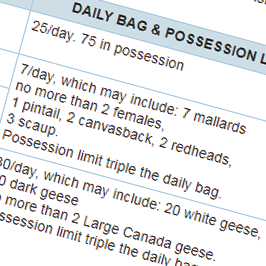Feb 25, 2018
CWA seeks 3-pintail limit
 California Waterfowl has asked the Pacific Flyway Council to develop options allowing states to choose a three-pintail bag limit, and will be discussing this issue with the Council when it meets in March in Norfolk, Virginia.
California Waterfowl has asked the Pacific Flyway Council to develop options allowing states to choose a three-pintail bag limit, and will be discussing this issue with the Council when it meets in March in Norfolk, Virginia.
In a detailed letter, CWA noted that California’s midwinter index of pintail is approximately 1 million birds, representing a substantial share of the entire continental population.
Waterfowl surveys conducted throughout the hunting season, including those in the Central Valley and Klamath Basin, often show that a plurality (and in some cases a majority) of all ducks surveyed are pintail.
CWA believes the needs and preferences of hunters must be considered in the waterfowl regulatory process, and that greater hunter opportunity would aid in recruitment, retention and reactivation efforts (learn more about R3 on page 6). It also believes states should be given as much flexibility as possible to tailor their regulations to meet their hunters’ needs, to the extent that it can be biologically justified.
A three-pintail daily limit may encourage private landowners to flood earlier and manage their marshes or agricultural lands in other ways that benefit wintering pintail. Prior to restrictive pintail limits, many private duck clubs had habitat that favored pintail, but they switched to more mallard-friendly habitat when pintail limits dropped.
Because waterfowl hunting generates important additional revenues, particularly for rice farmers, more liberal pintail regulations may also encourage farmers to maintain rice cultivation rather than switching to other crops, particularly nut crops, such as almonds and walnuts, which have little or no value to waterfowl.
The last three decades of restrictive regulations on pintail have not resulted in a significant boost in pintail populations, even in years of good precipitation in the prairies. Changing farming practices, especially in wheat fields favored by nesting pintail, may be the main factor limiting pintail populations, not hunter harvest.
Pintail populations from Alaska, which are more stable than those in the prairies, appear to provide a greater portion of the harvest in Pacific Flyway states, including California, in recent years. Since 1990, approximately one third of the Pacific Flyway pintail harvest source has shifted from the Canadian Prairies to Alaska.
A 2017 study (“Northern Pintail (Anas acuta) survival, recovery, and harvest rates derived from 55 years of banding in Prairie Canada, 1960-2014,” by Bartzen and Dufour) concluded that “there was no clear evidence that hunting bag limit restrictions affected annual survival, recovery, or harvest rates. In addition, we could find no compelling evidence that harvest mortality was substantially additive to non-harvest mortality for pintails.”
The study recommended increasing the daily pintail limit for five to ten years to help further assess the impact of harvest on pintail without causing a significant, negative impact on pintail populations. CWA urged the Pacific Flyway Council to consider implementing such a trial.

—Mark Hennelly, Vice President for Legislative Affairs and Public Policy
Originally published in California Waterfowl Magazine, Spring 2018. To receive the magazine, join CWA - click here.


